![]()
![]()
![]()
Use LEFT and RIGHT arrow keys to navigate between flashcards;
Use UP and DOWN arrow keys to flip the card;
H to show hint;
A reads text to speech;
185 Cards in this Set
- Front
- Back
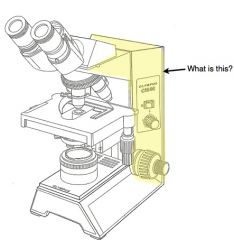
|
Arm
|
|
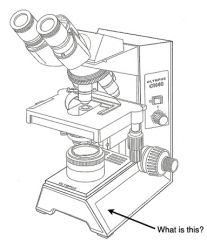
|
Base
|
|
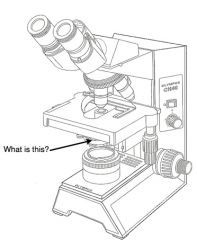
|
Condenser
|
|
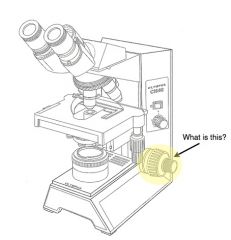
|
Course and Fine Focus Knobs
|
|
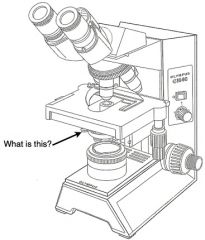
|
Iris diaphragm
|
|
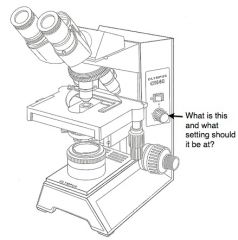
|
Light Rheostat and should be set at 4.5
|
|
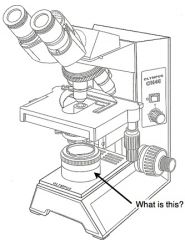
|
Light Source
|
|
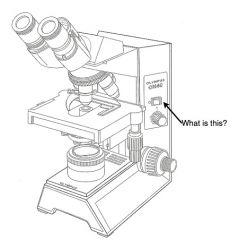
|
Light Switch
|
|
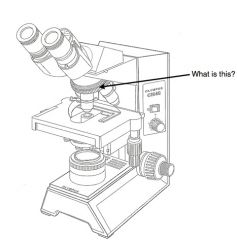
|
Objective Lenses
|
|

|
Ocular Lenses (10x)
|
|
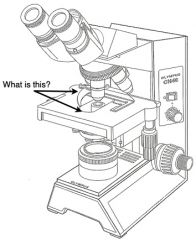
|
Stage with Stage Clips
|
|
|
What power objective lens should you start with for all bacterial slides?
|
10x
|
|
|
What power objective lens should you start with for all eukaryotic slides?
|
4x
|
|
|
Should you always view bacteria slides in oil immersion?
|
yes the 100x objective lens
|
|
|
Define total magnification.
|
Objective lens x Ocular lens (10x)
|
|
|
What is resolution?
|
is the amount of detail you can see in an image.
|
|
|
What is the Sterile Technique?
|
allows for the transfer of organisms from one place to another without contamination.
|
|
|
What is a pure culture?
|
Means that only one type of organism is present.
|
|
|
Define aseptic technique?
|
vital in hospital settings in preventing cross contamination; flame sterilization of all instruments and tools all the time.
|
|
|
What percentage of hospitalized patients acquire healthcare associated infections?
|
5 to 15%
|
|
|
What is
nosocomial infections |
hospital acquired infections
|
|
|
Why do we perform the streak plate technique?
|
to produce isolated colonies of one species of bacteria
|
|
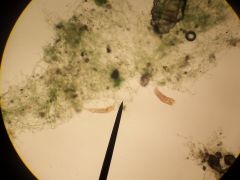
What is this?
|
pond water (the algae help identify it since it shows up green)
|
|
|
Which organisms in pond water are eukaryotic?
|
Algae and protozoa
|
|
|
why is fluorescence microscopy is used
|
provides contrast to see specimen glowing a color against a dark background
|
|
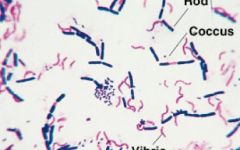
Identify the types of cells
|
Rod & Coccus
|
|
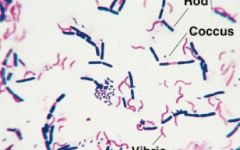
What type of staining technique is used?
|
Gram stain
|
|

What type of staining technique is used?
|
Leifson Flagella stain
|
|
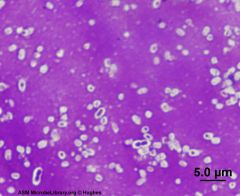
What type of staining technique is used?
|
Capsule Stain
|
|
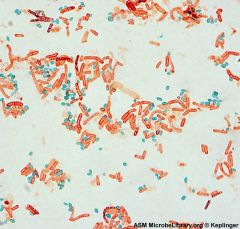
What type of staining technique is used?
|
Schaeffer-Fulton endospore stain
|
|
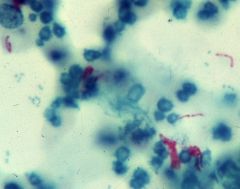
what type of staining technique is used?
|
Ziehl-Neelsen stain
|
|
|
What type of stain is the Gram stain?
|
A differential stain, 1st stain of choice in identifying an unknown.
|
|
|
What are the steps of a Gram Stain
|
Heat fix smear
Primary stain is applied mordant is added decolorized with ethanol counterstain (safranin) Wash |
|
|
What type of mordant is used in the gram stain?
|
Iodine
|
|
|
What is the primary stain used in the Gram Stain?
|
Crystal Violet
|
|
|
What is the counterstain used in the Gram Stain?
|
Safranin (red)
|
|
|
Name four secondary stains
|
Acid-fast
Endospore Flagella Capsule |
|
|
What type of technique is used in the Acid Fast Stain?
|
Ziehl Neelsen
|
|
|
What is the primary stain used in the Ziehl Neelsen technique?
|
Carbolfuschin (pink)
|
|
|
What is the counterstain used in the Ziehl Neelsen technique?
|
Methylene blue
|
|
|
Which two techniques are used for endospore stains?
|
1 - crystal violet method
2 - schaeffer-fulton method |
|
|
Describe the crystal violet method
|
negative staining technique
stains vegetative cells highlighting endospores in purple |
|
|
describe the shaeffer fulton method
|
uses a primary stain malachite green to stain endospores
rinse counter stain safranin |
|
|
What technique is used for the flagella stain
|
Leifson's flagella
|
|
|
Describe Leifson's flagella
|
rolling drop slide
air dried stain (contains a mordant) applied -inflate flagella |
|
|
What is the special external protective layer that makes viewing capsules possible?
|
defined by the form of glycocalyx; an external outer protective layer
|
|
|
Define the capsule stain
|
negative stain
uses India Ink to stain background Counterstain Safranin to stain bacterial cells air dried; heat fixing gives false results |
|
|
What is brownian motion?
|
vibration effect
|
|
|
how do you determine motility?
|
Using a hanging drop technique
purposeful forward swimming |
|
|
Motility: Is it motile and what is it's shape?
Bacillus subtilis |
M+, big rod
|
|
|
Motility: Is it motile and what is it's shape?
Enterobacter aerogenes |
M+, rod
|
|
|
Motility: Is it motile and what is it's shape?
Klebsiella pnemoniae |
M-, rod
|
|
|
Motility: Is it motile and what is it's shape?
Micrococcus luteus |
M-, coccus
|
|
|
Motility: Is it motile and what is it's shape?
Proteus Mirabilis |
M+, rod
|
|
|
Motility: Is it motile and what is it's shape?
Rhodospirillum rubrum |
M+, rod
|
|
|
Motility: Is it motile and what is it's shape?
Sporosarcina ureae |
M+, coccus
|
|
|
Motility: Is it motile and what is it's shape?
Janthinobacterium lividum |
M+, rod
|
|
|
What is the Gram Rxn & Morphology for:
Bacillus Subtilis (agar) |
G+, rod
|
|
|
What is the Gram Rxn & Morphology for:
Bacillius Subtilis (broth) |
G+, rod
|
|
|
What is the Gram Rxn & Morphology for:
E.Coli (agar) |
Gneg, rod
|
|
|
What is the Gram Rxn & Morphology for:
E. Coli (broth) |
Gneg, rod
|
|
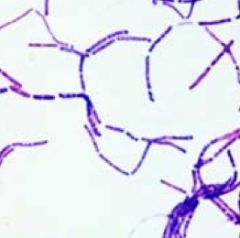
Identify the bacteria, Gram reaction and morphology.
|
Bacillus subtilis
G+ Rod |
|

Identify the bacteria, gram reaction, and morphology.
|
E. Coli
Gneg Rod |
|
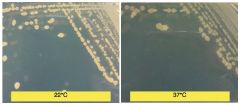
Identify the bacterium based on colony morphology and it's optimal temperature.
|
Bacillus Globigii
37*C |
|

Identify a bacterium based on colony morphology and its optimum temperature.
|
Bacillus Licheniformis
37*C |
|
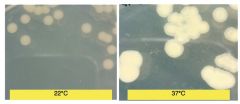
Identify a bacterium based on colony morphology and its optimum temperature.
|
Bacillus Megaterium
Not much difference b/w temperatures. |
|

Identify a bacterium based on colony morphology and its optimum temperature.
|
Bacillus Mycoides
22*C Fungal/Mold like growth |
|
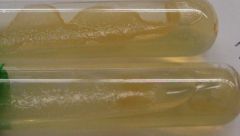
Identify the bacterium based on pigmentation and note any specifics re: temperature.
|
Bacillus globigii
No noticeable differences b/w temperatures. |
|

Identify the bacterium based on pigmentation and note any specifics re: temperature.
|
Chromobacterium violaceum
slightly darker at 22*C |
|
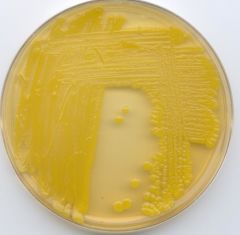
Identify the bacterium based on pigmentation and note any specifics re: temperature.
|
Micrococcus luteus
bright yellow at both 22 and 37*C |
|
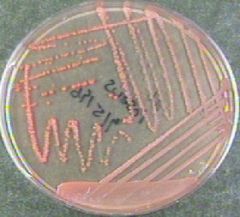
Identify the bacterium based on pigmentation and note any specifics re: temperature.
|
Micrococcus roseus
salmon pink only grows at 22*C |
|
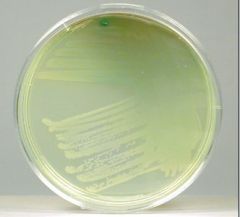
Identify the bacterium based on pigmentation and note any specifics re: temperature.
|
Pseudomonas aeruginosa
opaque yellow at 22 watery blue at 37 |
|
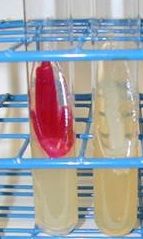
Identify the bacterium based on pigmentation and note any specifics re: temperature.
|
Serratia marcescens
Red at 22*C |
|
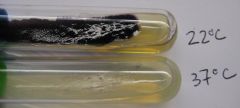
Identify the bacterium based on pigmentation and note any specifics re: temperature.
|
Janthinobacterium lividum
dark purple at 22*C NG at 37*C |
|
|
Why do non-photosynthetic bacteria produce pigments?
|
as byproducts of metabolism, as antioxidants, and as protection against solar radiation.
|
|

Name the slime mold that we used in lab and the medium used.
|
Physarum polycephalum sclerotia
Tap water agar plates (2%) |
|
|
Define cytoplasmic streaming.
|
The flow of oxygen and nutrients from one part of the plasmodium to another in protoplasmic vessels.
|
|
|
Define hanging drop slide
|
suspends bacteria in a drop of fluid, reducing evaporation and water currents when compared to regular wet mounts.
|
|
|
Define osmotic pressure
|
indicates the solute concentration of the surrounding solutions and the effect it has on the flow of water across the membrane.
|
|
|
What is the term to describe water leaving a cell that results in cell dehydration and shrinkage?
|
plasmolysis
|
|
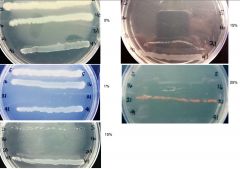
Identify the test and the bacterium had the widest range of salt tolerance and explain why. Which bacterium is an example of an obligate halophile.
|
Osmotic Pressure Test
Widest Range: Staphylococcus epidermidis (up to 15% NaCl) because it lives in salty human skin Obligate Halophile: Halobacterium salinarium |
|
|
True or False: Bacillus stearothermophilus is an example of a thermophile.
|
Bacillus stearothermophilus
|
|
|
Name the five temperature classifications for organisms.
|
Psychrophiles "cold loving"
Psychrotrophs Mesophiles "middle loving" Thermophiles "heat loving" Hyperthermophiles/Extreme thermophiles |
|
|
What it the temperature range for psychrophiles?
|
-5*C and <19/20*C
|
|
|
What it the temperature range for psychrotrophs?
|
-1*C and 35*C
|
|
|
What it the temperature range for Mesophiles?
|
12*C to 45*C
optimum 37*C |
|
|
What it the temperature range for thermophiles?
|
41*C and 80*C
|
|
|
What it the temperature range for Hyperthermophile?
|
75*C and 112*C
|
|
|
Which is room temperature:
37*C or 22*C |
22*C
|
|
|
Which is body temperature:
37*C or 22*C |
37*C
|
|
|
Define
bacteriostatic |
subsequent growth after initial incubation
|
|
|
Define
bacteriocidal |
lack of growth after initial incubation
|
|
|
What are two examples of bacteriocidal methods
|
Cooking and boiling
|
|
|
What are two examples of bacteriostatic methods
|
Refrigerating and freezing
|
|
|
What is the classification, optimum temp and temp range for
Bacillus licheniformis |
Mesophile
Optimum 37*C Range: 12*C to 45*C |
|
|
What is the classification, optimum temp and temp range for
Bacillus stearothermophilus |
Thermophile
Optimum: 55*C Range: 41*C and 80*C |
|
|
What is the classification, optimum temp and temp range for
E.Coli |
Mesophile
Optimum: 37*C Range: 12*C to 45*C |
|
|
What is the classification, optimum temp and temp range for
Janithinobacterium lividum |
Psychotroph
Optimum 22*C Range: -1*C and 35*C |
|
|
If a bacterium grows at a warmer temperature after incubating in a colder temperature - it is...
|
bacteriostatic
|
|
|
If a bacterium fails to grow at a warmer temperature after incubating in a colder temperature - it is...
|
bacteriocidal
|
|
|
What baceterium is an example of an anaerobe?
|
Clostridum sporogenes
|
|
|
Define obligate aerobes
|
require oxygen, possess enzymes, catalase and superoxide dismutase (SOD)
|
|
|
What is SOD
|
superoxide dismutase
|
|
|
What does catalase breakdown?
|
hydrogen peroxide into O2 and H2O
|
|
|
Define anaerobes
|
cannot use oxygen in metabolic pathways
|
|
|
Define
microaerophiles |
require only small amounts of O2 use aerobic respiration for energy
|
|
|
Define
Obligate anaerobes |
only grow when no O2 is present; use fermentation or anaerobic respiration for energy
|
|
|
Define
Facultative anaerobes |
can grow with or without O2; but grow best if O2 is present; possess enzymes, catalase and SOD
|
|
|
Define
Aerotolerant anaerobes |
primarily fermenters; possess enzyme and SOD
|
|
|
What does SOD breakdown?
|
breaks down superoxide radical into hydrogen peroxide
|
|
|
Which bacterium is an example of an obligate aerobe?
|
Bacillus subtilis
|
|
|
Which bacterium is an example of a strict anaerobe?
|
Clostridium sporogenes
|
|
|
Which bacterium is an example of a microaerophile and how can you tell?
|
Lactococcus lactis
best growth in reduced O2 when compared to AER tubes |
|
|
Which bacteria are facultative anaerobes?
|
Enterobacter aerogenes & E.Coli
They will grow most near the top but appear throughout the tube |
|
|
Which bacterium is an example of aerotolerant anaerobe?
|
Lactobacillus casiae
will look as though growing from bottom up |
|
|
Describe how UV radiation controls bacterial growth.
|
UV radiation kills microorganisms by damaging DNA. It creates thymine dimers that distort DNA, which lead to replication and transcription problems.
|
|
|
Do bacteria have light and dark repair enzymes?
|
Yes but these can be overwhelmed if exposure is significant.
|
|
|
Which type of environments are most susceptible to UV radiation?
|
Microrganisms in air, clear water, and on surfaces.
|
|
|
How do hospitals use UV radiation?
|
In germicidal lamps (ORs and nurseries).
|
|
|
Differentiate a disinfectant from an antiseptic.
|
Disinfectant is generally a chemical that kills or inhibits vegetative microbes. An ANTISEPTIC is a type of disinfectant that is nontoxic enough to be applies to skin and mucous membranes.
|
|
|
Is this an antiseptic or disinfectant?
Isopropyl Alcohol (IA) |
Antiseptic
|
|
|
Is this an antiseptic or disinfectant?
Hydrogen Peroxide (HP) |
Antiseptic
|
|
|
Is this an antiseptic or disinfectant?
Lysol (Ly) |
Disinfectant
|
|
|
Is this an antiseptic or disinfectant?
Bleach (Bl) |
Disinfectant
|
|
|
What does a zone of inhibition indicate?
|
antimicrobial activity
|
|

You are looking at Bacillus Subtilis. Which chemical was LEAST effective and is it a disinfectant or an antiseptic?
|
Isopropyl alcohol
antiseptic |
|

Identify this bacterium. Hint: it was the only one that had NG for HP and Bl and it is "topical".
|
Staphylococcus epidermidis
|
|
|
Which of these bacterial species is most UV resistant/tolerant and why?
Bacillus Subtilis, E. Coli, Staphylococcus epidermidis |
Bacillus subtilis; endospores resist UV;
|
|
|
You are traveling when you suddenly need surgery. The village hospital only has liquid hand soap available for their doctors to scrub in. You have a small bottle of alcohol-based hand sanitizer in your day pack.
Do you... A) go with the liquid based soap B) insist on the alcohol based hand sanitizer EXPLAIN WHY |
B - you insist on the alcohol-based hand sanitizer because
-it is more effective at killing transient organisms and agents -it reduces the number of hospital acquired infections -and you saw in lab that it killed 93% of bacteria present on your partner's hands. |
|
|
True or False:
Molds belong to the Kingdom Plantae? |
False. Molds belong to the Kingdom Fungi
Molds include mushrooms, mildew, and bread mold. |
|
|
True or False:
Yeasts belong to the Kingdom Bacteria? |
False. Yeasts belong to the Kingdom Fungi include unicellular nonmotile yeasts.
|
|
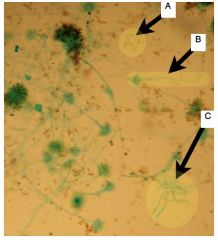
Identify these life stages and identify type of mold.
|
A. Spores
B. Spore germinating hypha C. Hyphae going to Mycelium Aspergillus Mold |
|
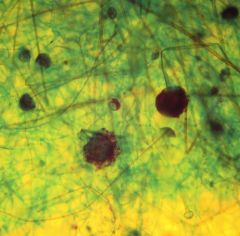
Name this mold.
|
Rhizopus
|
|
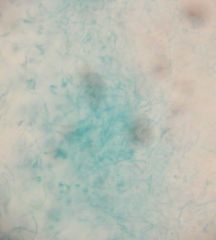
Name this mold.
|
Penicillium
|
|
|
What was the name of the selective medium used in the mold lab?
|
Sabouraud Agar due to its low pH and high sugar concentration which inhibits bacterial growth
|
|
|
What stain was used to make the molds visible?
|
lactophenol cotton blue
|
|
|
How did we collect the mold?
|
Tape and toothpicks.
|
|
|
What was the name of the yeast used in lab?
|
Saccharomyces cerevisiae
|
|
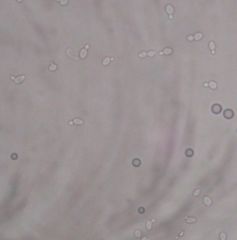
What are you looking at?
|
Budding Yeast is most clearly present
|
|

What is it?
|
Yeast ascospore
|
|
|
What method is used to estimate the number of bacteria in the soil.
|
serial dilution of a sample of soil.
|
|
|
Define serial dilution
|
dilute one gram of sample soil through a series so that bacterial numbers are progressively decreased
|
|
|
Why, when using the serial dilution method, are estimates low?
|
because the artificial and limited growing conditions are not suitable for all organisms.
|
|
|
You CFU count for soil bacteria is 88 on a 10*-6 (power) plate. Is the CFU of original gram sample:
A. 88 CFUs B. 88 x 10*-6 CFUs C. 8.8 x 10*7 CFUs |
8.8 x 10*7 (power) of CFUs
|
|
|
Define coliforms
|
all aerobic and facultative anaerobic Gneg rods which produce acid and gas from lactose fermentation in 48 hours at 35*C
|
|
|
Coliforms
AKA |
indicator organisms
|
|
|
What is the 2nd step of water testing?
|
Confirmed Test
|
|
|
What are the three steps of water testing (in order)?
|
Presumptive Test
Confirmed Test Completed Test |
|
|
What constitutes a positive presumptive test (possible coliforms)?
|
both acid and gas present
(yellow and bubble in durham tube) |
|
|
In a presumptive test what do yellow and blue tubes with no bubbles indicate?
|
Yellow indicates presence of acid and blue means no acid was produced; no bubble means no lactose fermentation.
|
|
|
How do you calculate the MPN of a presumptive test?
|
Count the number of positive big tubes; look at chart; count the number of positive baby tubes; look at chart; arrive at answer.
|
|
|
Why must the confirmed test be performed for water testing?
|
it is necessary due to the synergism of the mixed bacteria in a tube; giving a false positive.
|
|
|
In the confirmed tests (water) name the differential and selective mediums used.
|
Differential medium: EMB Eosin Methylene Blue
Selective medium: EMB Eosin Methylene Blue |
|
|
Describe Eosin Methylene Blue as a differential medium
|
a differential medium because it contains lactose and dyes - it differentiates non-coliforms by dying coliform colonies
|
|
|
Describe Eosin Methylene Blue as a selective medium
|
As a selective medium EMB selects Gram negative bacteria
|
|
|
why does a green sheen appear on E. coli. EMB agar plates?
|
The acids cause a reduction in pH and precipitate the dye complex (methylene blue eosinate) "dye sink" onto the colonies
|
|

Identify they areas as indicated.
|
A. E.Coli due to green sheen
B.Enterobacter aerogenes due to pink colonies C. Non-Coliforms colorless colonies that transmit the reddish-purple color of the medium D. Enterobacter aerogenes forming purple colonies (note no green sheen) |
|
|
What is a parasite?
|
An organism that lives on or in another organism causing harm.
|
|
|
Describe ectoparasites
|
Ectoparasites live on the host
Complex life cycle multiple morphologies sexual and asexual reproduction multiple hosts protozoa - single celled motile |
|
|
Describe eukaryotic parasites
|
the human serves as a reservoir of infection
|
|
|
What are the major ways that parasites are spread?
|
Via food, water, vectors, soil
|
|
|
What is a vector?
|
Organism that transmits an organism from one stage to another
e.g., Anthropods (insects) |
|
|
What is an intermediate host?
|
Intermediate Host provides a living space where parasites asexually reproduce
|
|
|
What are some ways that scientists are using to try and stop/slow the spread of parasites.
|
Protective measures for food and water supply
Filtration of water and access to clean water |
|
|
can parasites ever be completely eliminated?
|
Uncontrollable and they can infect multiple hosts that can infect humans
|
|
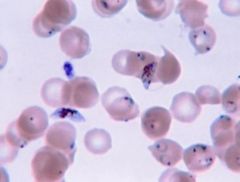
Identify the picture.
|
Plasmodium Falciparum (Malaria infection)
|
|

Identify the picture
|
Ascaris lumbricoides eggs
|
|
|
Name the three categories of Helminths.
|
Nematodes - round worms
Cestodes - tapeworms Trematodes - Flukes |
|
|
Which category contains Ascaris lumbricoides:
Nematodes, Cestodes, Trematodes |
Nematodes
|
|
|
How is malaria vectored?
|
Via the female mosquito Anopheles
|
|
|
Name some malaria prevention methods.
|
Prophylactic medications
prevention of mosquito bites mosquito eradication (insecticides) |
|
|
List some diseases vectored by mosquitos.
|
Malaria
filariases dengue fever yellow fever west nile virus |
|
|
list some diseases vectored by ticks
|
lyme disease
rocky mountain spotted fever ehrlichiosis |
|
|
If you have a starch agar medium and there is a clear area around the growth line of a bacteria; what test are you looking at?
|
Amylase Test
Positive = clear area around bacteria growth line iodine reagent used to visualize exoenzymes present |
|
|
If you have a tributyrin agar medium and there is a clear area around the growth line of a bacteria; what test are you looking at?
|
Lipase
Positive = clear area around bacteria growth line |
|
|
If you have a gelatin agar medium and there is a clear area around the growth line of a bacteria; what test are you looking at?
|
Gelatinase
Positive = clear area around bacteria growth line |
|
|
Of the exoenzyme test what was the trend?
|
Bacillus subtilis tested positive for exoenzymes across all three.
|
|
|
Describe Catalase test
|
Tests for the respiration enzyme catalase using substrate hydrogen peroxide
Positive = bubble formation |
|
|
Describe oxidase test
|
tests for the respiration enzyme cytochrome c oxidase
positive = purple spot |
|
|
Describe the nitrate reduction test 1
|
tests for the ability to reduce nitrate to nitrite using nitrate reductase in potassium nitrate broth
positive = bubbles present |
|
|
Describe nitrate reduction test 2
|
tests for nitrite using reagents sulfuric acid and Tromsdorff's reagent
Positive = immediate purple brown |
|
|
Describe nitrate reduction test 2
|
testing for nitrate
zinc added to negative nitrite tests positive = purple brown negative = reduction to another gas like ammonia possible |
|
|
For the nitrate reduction tests, what were the two extremes?
|
Bacillus megaterium immediate results;
Pseudomonas aeruginosa N2 gas positive only |
|
|
For the carbohydrate fermentation tests what were the three sugars tested for?
|
Glucose, Lactose, Sucrose
|
|
|
Of the carbohydrate tests, what were the two extremes?
|
Alcaligenes faecalis grew on peptones for all three GLS
E.Coli the only one with AG for all three sugars |

